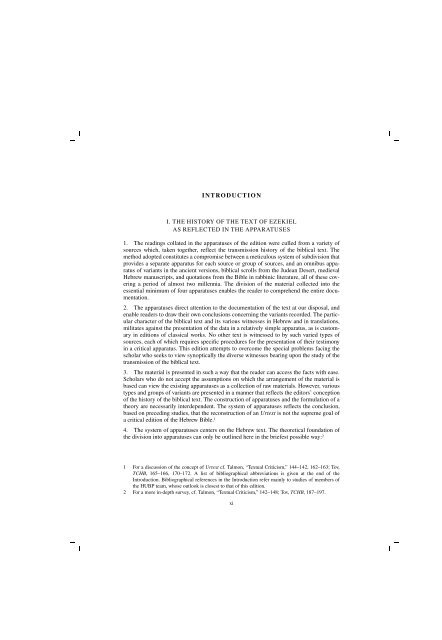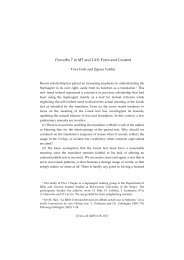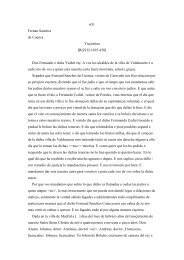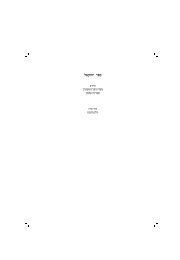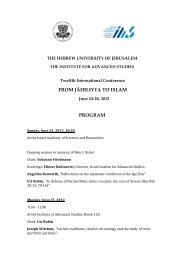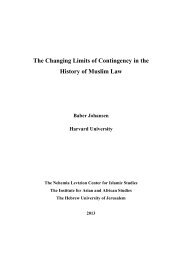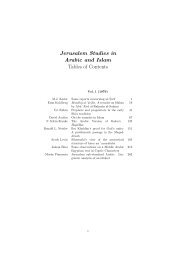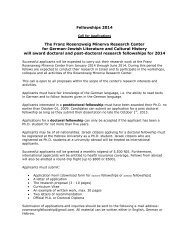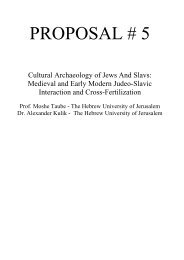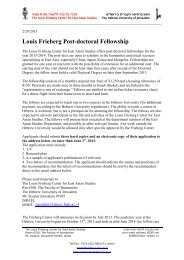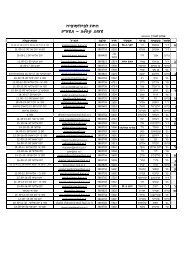THE BOOK OF EZEKIEL Moshe H. Goshen-Gottstein Shemaryahu ...
THE BOOK OF EZEKIEL Moshe H. Goshen-Gottstein Shemaryahu ...
THE BOOK OF EZEKIEL Moshe H. Goshen-Gottstein Shemaryahu ...
Create successful ePaper yourself
Turn your PDF publications into a flip-book with our unique Google optimized e-Paper software.
INTRODUCTION<br />
I. <strong>THE</strong> HISTORY <strong>OF</strong> <strong>THE</strong> TEXT <strong>OF</strong> <strong>EZEKIEL</strong><br />
AS REFLECTED IN <strong>THE</strong> APPARATUSES<br />
1. The readings collated in the apparatuses of the edition were culled from a variety of<br />
sources which, taken together, reflect the transmission history of the biblical text. The<br />
method adopted constitutes a compromise between a meticulous system of subdivision that<br />
provides a separate apparatus for each source or group of sources, and an omnibus apparatus<br />
of variants in the ancient versions, biblical scrolls from the Judean Desert, medieval<br />
Hebrew manuscripts, and quotations from the Bible in rabbinic literature, all of these covering<br />
a period of almost two millennia. The division of the material collected into the<br />
essential minimum of four apparatuses enables the reader to comprehend the entire documentation.<br />
2. The apparatuses direct attention to the documentation of the text at our disposal, and<br />
enable readers to draw their own conclusions concerning the variants recorded. The particular<br />
character of the biblical text and its various witnesses in Hebrew and in translations,<br />
militates against the presentation of the data in a relatively simple apparatus, as is customary<br />
in editions of classical works. No other text is witnessed to by such varied types of<br />
sources, each of which requires specific procedures for the presentation of their testimony<br />
in a critical apparatus. This edition attempts to overcome the special problems facing the<br />
scholar who seeks to view synoptically the diverse witnesses bearing upon the study of the<br />
transmission of the biblical text.<br />
3. The material is presented in such a way that the reader can access the facts with ease.<br />
Scholars who do not accept the assumptions on which the arrangement of the material is<br />
based can view the existing apparatuses as a collection of raw materials. However, various<br />
types and groups of variants are presented in a manner that reflects the editors’ conception<br />
of the history of the biblical text. The construction of apparatuses and the formulation of a<br />
theory are necessarily interdependent. The system of apparatuses reflects the conclusion,<br />
based on preceding studies, that the reconstruction of an Urtext is not the supreme goal of<br />
a critical edition of the Hebrew Bible. 1<br />
4. The system of apparatuses centers on the Hebrew text. The theoretical foundation of<br />
the division into apparatuses can only be outlined here in the briefest possible way: 2<br />
1 For a discussion of the concept of Urtext cf. Talmon, “Textual Criticism,” 144–142, 162–163; Tov,<br />
TCHB, 165–166, 170–172. A list of bibliographical abbreviations is given at the end of the<br />
Introduction. Bibliographical references in the Introduction refer mainly to studies of members of<br />
the HUBP team, whose outlook is closest to that of this edition.<br />
2 For a more in-depth survey, cf. Talmon, “Textual Criticism,” 142–148; Tov, TCHB, 187–197.<br />
xi


